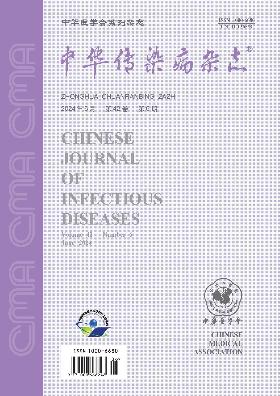Evolution of VP1 gene of coxsackievirus A16 in hand, foot, and mouth disease
引用次数: 0
Abstract
Objective To investigate the genetic evolution of VP1 gene of pathogenic coxsackievirus A16 (CV-A16) strain isolated from clinical hand, foot, and mouth disease (HFMD) patients. Methods A total of 160 HFMD cases with CV-A16-positive results were collected from hospitals in Kunming during January 2015 to June 2017. Fecal samples were collected. Real-time polymerase chain reaction (PCR) was used to detect the CV-A16 virus nucleic acid. The VP1 genes of CV-A16-positive samples were amplified by reverse transcription-PCR. The amplified positive products were sequenced and aligned. The homologies were identified and their subgenotypes were determined. The phylogenetic tree was constructed and homology modeling was conducted. Results All the 160 CV-A16 isolates were B2 subtypes. The genetic distance between detected strains of CV-A16 and the strains in Fujian, Beijing, Nanjing was 0.76. The genetic distance to the strains in Malaysia was 0.78, and to the strains in Australia was 1.86. Homologous modeling revealed that the amino acid sequence of the VP1 gene of the strain had a G227R mutation. Conclusions There is no major genetic variation in the CV-A16 strains during 3 years. CV-A16 isolates are close to those of epidemic strains in Beijing, Fujian and Malaysia, but are far fram the strains from Australia. Key words: Hand, foot and mouth disease; Coxsackievirus A16; VP1 gene; Phylogenetic tree; Homology modeling手足口病柯萨奇病毒A16 VP1基因的进化
目的研究临床手足口病(HFMD)患者分离的致病性柯萨奇病毒A16(CV-A16)株VP1基因的遗传进化。方法收集2015年1月至2017年6月昆明市医院收治的160例CV-A16阳性手足口病患者。收集粪便样本。采用实时聚合酶链式反应(PCR)检测CV-A16病毒核酸。用逆转录聚合酶链式反应扩增CV-A16阳性标本的VP1基因。对扩增的阳性产物进行测序和比对。鉴定了它们的同源性,并确定了它们的亚基因型。构建了系统发育树,并进行了同源性建模。结果160株CV-A16均为B2亚型。检测到的CV-A16菌株与福建、北京、南京菌株的遗传距离为0.76。与马来西亚株系的遗传距离为0.78,与澳大利亚株系的基因距离为1.86。同源模型显示该菌株VP1基因的氨基酸序列具有G227R突变。结论CV-A16菌株在3年内无明显的遗传变异。CV-A16分离株与北京、福建和马来西亚的流行株接近,但与澳大利亚的流行株相差甚远。关键词:手足口病;柯萨奇病毒A16;VP1基因;系统发育树;同源性建模
本文章由计算机程序翻译,如有差异,请以英文原文为准。
求助全文
约1分钟内获得全文
求助全文
来源期刊
自引率
0.00%
发文量
5280
期刊介绍:
The Chinese Journal of Infectious Diseases was founded in February 1983. It is an academic journal on infectious diseases supervised by the China Association for Science and Technology, sponsored by the Chinese Medical Association, and hosted by the Shanghai Medical Association. The journal targets infectious disease physicians as its main readers, taking into account physicians of other interdisciplinary disciplines, and timely reports on leading scientific research results and clinical diagnosis and treatment experience in the field of infectious diseases, as well as basic theoretical research that has a guiding role in the clinical practice of infectious diseases and is closely integrated with the actual clinical practice of infectious diseases. Columns include reviews (including editor-in-chief reviews), expert lectures, consensus and guidelines (including interpretations), monographs, short monographs, academic debates, epidemic news, international dynamics, case reports, reviews, lectures, meeting minutes, etc.

 求助内容:
求助内容: 应助结果提醒方式:
应助结果提醒方式:


